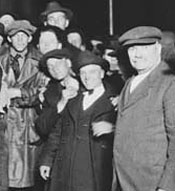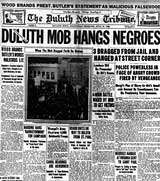|
|||||||||||||||
|
The Story
Resources
Background
|
By Chris Julin and Stephanie Hemphill
June 2001
 Some of the onlookers who posed for the camera after the lynching of three black men in downtown Duluth on June 15, 1920.
Some of the onlookers who posed for the camera after the lynching of three black men in downtown Duluth on June 15, 1920. (Photo courtesy of Minnesota Historical Society) |
"This is where the mob broke in," says Michael Fedo, who wrote a book about the 1920 lynchings. "I think this was a Sears store or a hardware store. The mob came into this store - which is now the casino - and the proprietor gave them rope for the hangings and said it was on the house."
Standing in the heart of downtown Duluth, Fedo points across Superior St. to a handsome, three-story brownstone building full of offices. The word "POLICE" is still carved in the stone over the door.
Fedo says when the mob closed in on the police station, the city's public safety commissioner ordered the 12 officers inside to holster their guns. He didn't want anyone in the crowd to get hurt. A few officers came out onto the street, and tried to fight the mob back with their bare hands and a fire hose. But the crowd surged past them into the jail, with a roar that could be heard a mile away.
"Most of the cells were on the second floor, so they went in and broke into several of the cells."
While members of the mob sawed and smashed on the bars, some of the men inside the cells pleaded their innocence. Others prayed.
"The people in the mob believed that six had attacked the girl, so they tried to get six - they only managed to get into three of the cells. There were several people in the cells with the prisoners, asking questions, trying to find out in their minds who the six were among the more than a dozen who were in the cells," says Fedo.
"The people who were outside were saying, 'Just give us somebody,' and that first somebody was a young man named Isaac McGhie, who was just thrown from the cell to the hands of the mob who took him out front, brought him up the hill here one block, where he was the first one hanged," Fedo recalls.
|
" These are not people who are ashamed to be seen here. This is, 'I want to be in this picture.'" - Author Michael Fedo
|
Isaac McGhie was beaten and bloody when he got to this corner, right next to the Duluth Shrine Temple, which is still here.
"This is where they were brought to be hanged. I don't know why they would have been brought up the hill instead of down the hill. But it may have been because there was a young man perched on top of this pole, and they just assumed, 'He's already there, we'll take them up there, we'll have this kid tie a knot on the lamppost above the street, and take care of business that way,'" says Fedo.
A priest named William Powers pushed his way to the front of the crowd, and climbed part way up the lamppost. The priest managed to quiet the crowd for a few moments. He begged them to stop. But members of the mob pulled Rev. Powers down, and hoisted Isaac McGhie up.
Then the mob dragged Elmer Jackson and Elias Clayton out of the jail, and up the hill to the street light. When all three men were hanging, battered and dead, the crowd parted so a photographer could capture the scene.
"This was a significantly posed photo," says Fedo. "It took a couple of automobiles with lights to illuminate the scene so the photographer could get his picture taken."
In the center of the crisp, black and white photo, Elmer Jackson and Isaac McGhie hang from the street light, stripped to the waist, their necks impossibly stretched and twisted. Elias Clayton lies beneath their feet, tossed onto the sidewalk, to make it easier to frame the picture. Dozens of men lean into the picture facing the camera.
"What this looks like is the kind of photo you would see at a hunting lodge, where the guys had been out shooting bear, and they came back and they said, 'We got three.' You can see people on tip-toe. They've crowded into this shot. These are not people who are ashamed to be seen here. This is, 'I want to be in this picture.'"
 The Duluth News Tribune's front page, the day after the lynchings.
The Duluth News Tribune's front page, the day after the lynchings. (Image courtesy of Minnesota Historical Society) See a larger image. |
"The one that quite stood out is the fellow who's to the left of the bodies who is beaming. He looks like he's very proud of what has transpired, and that is the face that really stands out to me," says Fedo.
Someone made postcards out of the photo, and sold them as souvenirs. Postcards of lynchings were fairly common. A recent book, Without Sanctuary, is a collection of photos and postcards from nearly 100 lynchings. It includes the picture from Duluth.
A lynching in northern Minnesota was big news. It made headlines across the country. It stayed in the local news for months during the criminal trials that followed. Juries in Duluth convicted three men of rioting. The longest sentence served was two years. No one was convicted of murder. But one of the black men who survived the attack on the jail was convicted of rape, in spite of compelling evidence he was innocent. He served four years in prison.
And then, the story of the lynching disappeared from the news.

